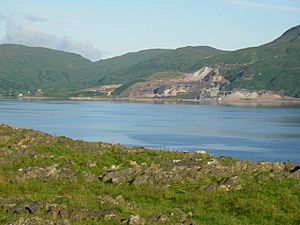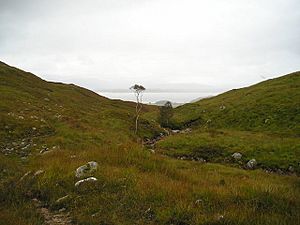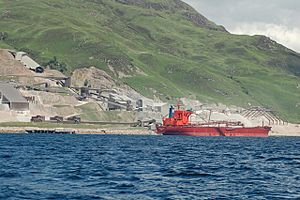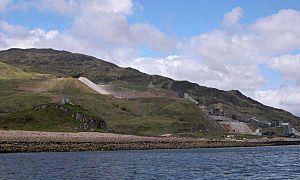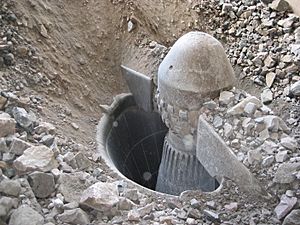Glensanda facts for kids
Quick facts for kids Glensanda |
|
|---|---|
| • Edinburgh | 190 mi or 310 km (road) (149 mi or 240 km via Corran Ferry) |
| • London | 567 mi or 912 km (road) (526 mi or 847 km via Corran Ferry) |
| Civil parish | |
| Council area | |
| Lieutenancy area | |
| Country | Scotland |
| Sovereign state | United Kingdom |
| Dialling code | 01631 |
| Police | Northern |
| Fire | Highlands and Islands |
| Ambulance | Scottish |
| EU Parliament | Scotland |
| UK Parliament |
|
| Scottish Parliament | |
Glensanda is a very remote place in the Highlands of Scotland. Its name comes from Old Norse, meaning "the glen of the sandy river." It was once a Viking settlement. Glensanda is located on the Morvern peninsula in Lochaber, looking out over the island of Lismore and Loch Linnhe.
Glensanda Castle, also called Maiden's Castle, stands near the Glensanda River. This river flows 400 meters down to Loch Linnhe. The castle was the main home for the Macleans of Kingairloch starting in the 15th century. Around 1812, almost all 500 people living there moved to Pictou, Nova Scotia, Canada.
Getting to Glensanda is tricky because there are no roads, railways, or marked paths. The area is covered in granite mountains, moorland, heather, and peat bogs. The only way to reach Glensanda is by boat from Loch Linnhe.
Since 1982, the Glensanda area has been home to the Glensanda Superquarry. This huge quarry, now owned by Aggregate Industries, mines granite from Meall na h-Easaiche mountain. It ships up to 6 million tons of granite around the world each year. The quarry is built about 1 mile (1.6 km) inland and cut into the mountain to hide it from the coast.
Contents
A Look Back: Glensanda's History
Not much is known about Glensanda before the Viking Age. It was part of Dál Riata, a large Gaelic kingdom in western Scotland during the late 500s and early 600s AD. The area of Morvern was once known as Kinelvadon.
Viking Influence and Early Settlements
Glensanda was a Viking settlement at the mouth of Glen Sanda. Vikings first raided Scotland in the early 700s AD. Their first known attack was on the holy island of Iona in 794, which is about 40 miles (64 km) west of Glensanda. The Viking Age in Scotland is generally thought to have ended in 1266.
Glensanda Castle and the Maclean Clan
Glensanda Castle has several names, including Maiden's Castle. It was built in the late 15th century by Ewen MacLean, who was born around 1450. Glensanda became part of the Clan MacLean's land after the Clan MacMaster left the area in the 1400s.
The castle was the main home for the Macleans of Kingairloch. A busy community of about 500 people lived there until around 1780. At that time, many seem to have moved about 5 miles (8 km) north to Connach (Kingairloch).
Changes for the Maclean Clan
In the late 1600s, the MacLean clan started to face difficulties. By 1691, the Campbells had taken control of most of the MacLean lands. The Clan Maclean supported the Jacobite risings in 1745 and 1746. Many clan members died fighting at the Battle of Culloden. After this, many Macleans moved to other countries like Canada, the United States, Australia, and New Zealand.
In 1812, Sir Hector Maclean, who was the 7th Baronet of Morvern and the 23rd Chief of the Clan Maclean, moved to Pictou, Nova Scotia, Canada. Almost the entire population of 500 people went with him. This event was not part of the Highland Clearances, which were forced removals of people from the Scottish Highlands. Sir Hector is buried in Pictou.
New Owners of the Estate
After the Macleans left, an English landowner named James Forbes bought the estate from Sir Hector Maclean in 1812. He later extended the house at Connach, making it the first Kingairloch House.
In 1888, John Bell Sherriff, a distiller from Glasgow, bought the estate. Later, in 1902, George Herbert Strutt, a cotton businessman, bought both the Glensanda and Kingairloch estates. His son, Arthur Strutt, and his wife, Patricia Kebbell, lived there. Patricia Strutt was known for hunting deer.
The last person living alone in Glensanda died around the 1950s. By the 1980s, Glensanda was mostly ruins. It was known as "the Larder of Lorne" by people who hunted red deer and salmon without permission.
John Yeoman and his wife Angela bought the Glensanda estate in 1982. They later bought the Kingairloch estate in 1989. In 2006, their company, Foster Yeoman, was bought by the Holcim Group. It is now part of their Aggregate Industries company.
Glensanda Super Quarry: Mining Granite
In 1976, a report showed that more building materials were needed in the UK. This led John Yeoman to think about a "super-quarry" in a remote place where stone could be shipped out by sea. In 1982, he bought the Glensanda estate. The quarry started working in 1986, and the first ship of granite went to Houston, Texas, USA. In 1989, they began using a special "glory hole" and conveyor belt system.
To keep the quarry from being seen from the coast, it is built about 1 mile (1.6 km) inland. It is also cut down into the mountain, about 1,600 feet (488 meters) above sea level. Each time they blast, about 70,000 tons of granite are loosened. This granite is then taken by large trucks to a primary crusher, which breaks it into pieces no larger than nine inches (23 cm).
The crushed granite then goes onto a conveyor belt to a large pile. This pile covers the "glory hole," which is a 1,000-foot (305-meter) deep vertical shaft. Rocks fall down this shaft. At the bottom, deep inside the mountain, the rocks move onto another conveyor belt. This belt carries them through a 1-mile (1.6 km) long tunnel to a second crusher on the shore. Here, large ships are loaded with granite at a speed of 6,000 tons per hour.
In 1998, about 160 people worked at the quarry. Some lived on site, and others came by boat from Barcaldine. At that time, granite was being sent to places like Amsterdam, Hamburg, and Poland.
It is believed that there is enough granite at Glensanda to last until at least the year 2100. By then, the quarry will have created a new corrie (a bowl-shaped hollow) about 1.5 miles (2.4 km) square and 400 feet (122 meters) deep.
Nearby Places
 |
Ardery, Ardnamurchan, Eigg, Rùm, South Uist |
Achnalea, Glenfinnan, Mallaig, Isle of Skye |
Ardgour, Clovullin, Corran Ferry, Fort William, Inverness |
 |
| Acharn, Ardtornish, Bonnavoulin, Tobermory, Isle of Mull, Tiree |
Shuna Island, Loch Linnhe, Appin, Beinn Sgulaird, Rannoch Moor, Loch Rannoch, Pitlochry, |
|||
| Craignure, Duart Castle, Isle of Mull, Iona |
Lismore, Oban, Lochgilphead, Tarbert, Mull of Kintyre |
Coeffin, Lismore, Barcaldine, Castle Stalker, Oban, Glasgow |



